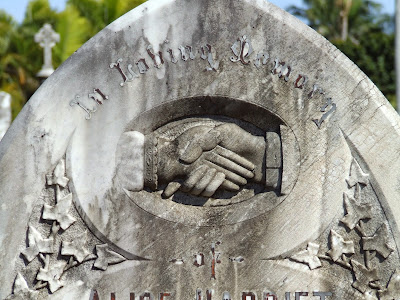 |
| Townsville's West End Cemetery, 2012. Photo: Trisha Fielding. |
The total number of burials at this cemetery has been estimated
to be over 8,000.[1] This
seems a reasonable estimate given that the burial register lists numbered
graves up to 7,718 along with the fact that graves often contained more than
one burial.
Religious Trends
Cemeteries provide a wealth of information
for the study of religious trends in a community. This is because denominational differences
are clearly reflected in epitaphs and mortuary symbolism. Roman Catholic, Church of England and
Presbyterian religions all have a high statistical representation in the West End Cemetery
Between 1901 and 1940, 41.4 per cent of burials were registered as Church of England, 23.8 per cent Roman Catholic, 13 per cent Presbyterian, 3.4 per cent Weslyan and 5 per cent Methodist.[3]
These figures are consistent with
Queensland-wide statistics. In 1891, religious adherence in Queensland
Headstone/monument shapes
Simple slab shapes such as Norman
and Gothic (after Georgian architecture) and anthropomorphic (human-like) were
used widely in the late eighteenth and early nineteenth centuries and are found
throughout the West End
Cemetery
 |
| This impressive monument was erected in memory of Viola Bismuth Noble. Photo: T. Fielding, 2012. |
Common symbols include the broken
column (for a life cut short), ivy (hope and immortality), the poppy (sleep),
the cross (faith), weeping willows (grief and loss), the broken chain (loss),
the dove and olive sprig (faith and renewal), the anchor (faith), the trumpet
(resurrection), clasped hands (farewell and reunion), an hourglass (the passing
of time), the bodyless, or winged cherub (the flight of the soul), a book (the
Bible or Book of Life), a rose (symbolising English origin), thistle
(symbolising Scottish origin) and the shamrock (symbolising Irish origin).[6]
Other interesting symbols found throughout this cemetery include Masonic symbols (compass and square) and the Knights Templar symbol (cross and crown).
 |
| Clasped hands, symbolising both farewell, and also hope of a reunion in the afterlife. (Note the male and female cuffs). Photo: Trisha Fielding, 2012. |
Other interesting symbols found throughout this cemetery include Masonic symbols (compass and square) and the Knights Templar symbol (cross and crown).
In my next blog I’ll talk about the differences in the symbolism used on the headstones for some of the different religious denominations in the
[1] Peter Bell and David Young,
unpublished report for the Townsville City Council, ‘West End
Cemetery
[2] K. M. Gillespie,
unpublished report, ‘A Monumental View of
West End ’ 1987, Appendix F, p. 2, held by City Libraries Townsville, Local History Collection.
[3] Ibid.
[4] Government Statistician’s Office, Queensland Past and Present: 100 Years of
Statistics, 1896-1996, Queensland Government, Brisbane
[5] Ibid.
[6] Graeme M. Griffin and Des Tobin, In the Midst of Life… The Australian Response to Death, 2nd
Edition, Melbourne
University
No comments:
Post a Comment